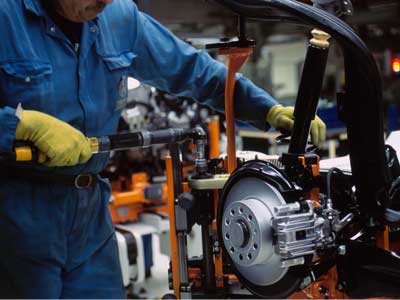How Brake Upgrades Work

For many cars and trucks, manufacturers seek the cheapest suppliers they can find to make each of the components that bolt together to form a complete automobile. That means your car's brakes, all the wiring, the seats, trim pieces, instruments -- they're all the collective creation of a bunch of low-cost producers.
While the car makers do subject their suppliers to specific standards for quality and performance, these often aren't good enough for the discerning consumer. As a result, many automotive enthusiasts choose to upgrade from the original equipment manufacturer (OEM) parts.
n this article, we'll examine the ins and outs of brake upgrades. We'll look at why you'd want a brake upgrade, some of the parts typically replaced in a brake upgrade and the types of upgrades possible.
The politically correct reason for wanting to upgrade your brakes is improved performance. Higher-quality brake parts can last longer, decrease stopping distance, perform better under extreme conditions and, as a result, improve your vehicle's safety. Of course, if you're trying to show off (without really looking like you're trying), nothing says performance more subtly than a set of big, vented rotors peeking out from behind custom rims.
Naturally, the most important high-performance brake part is your own good judgment. Perhaps you can go from 60 mph (97 kph) to a dead stop in 50 yards (46 meters). But that doesn't mean you should treat the street as if it were your own private racecourse. That said, brake upgrades provide you an extra margin of safety, which can make all the difference in a driving emergency.
It can be fun to make your car or truck go faster than the factory intended. But if you do, you'll want to be able to haul all that steel and rubber to a stop in a jiffy as well. To find out about performance brake upgrades, go to the next page.
Typical OEM brakes are designed for cars with standard engines, performing routine tasks: the morning and evening commute, grocery shopping, driving the kids to soccer practice, etc.
But if you subject your vehicle to stresses beyond the ordinary, then stock stoppers just won't do. By "beyond ordinary," we mean any power upgrades, such as nitrous oxide, turbochargers or superchargers, engine swaps and driving in particularly steep areas. In other words, your OEM brakes can easily become overwhelmed.
The most common occurrence is what car enthusiasts call brake fade. Under prolonged use on any given drive, your brakes will become less effective the harder they're stressed. That's because car brakes take the kinetic energy of your car's movement and disperse it as thermal energy -- heat -- when the calipers clamp down on the brake disc.
Beyond a certain temperature and loading amount, the stock brakes lose effectiveness. You may have experienced this if you've ever driven down a steep mountain road. After a while, you almost have to stomp on the pedal to get the car to slow down or stop.
If you race, high-performance brakes are a must. Performance brake upgrades are designed to dissipate this heat build-up more efficiently than standard equipment brakes. Let's look a little closer at each performance brake part.
Car enthusiasts go gaga over braided stainless steel brake lines -- the steel-encased Teflon flexes considerably less than ordinary rubber hoses, making for a firmer pedal feel. But controversy surrounds the safety of braided stainless steel hoses, since they can fail if they're not replaced regularly and protected from debris. If braided stainless steel is in your future, buy from a reputable supplier, and look for lines that come with a polyurethane jacket to prevent chafing.
Two more brake upgrades, cross-drilled rotors and slotted rotors, have made their way from the track to the streets. The purpose of both is to increase airflow over and away from the rotor (also known as the brake disc), with the moving air taking heat away with it.
As always with aftermarket parts, quality and safety are concerns. Many enthusiasts report that drilled and slotted rotors wear out more easily than stock or heavy-duty smooth rotors. The reason could be inferior materials or the fact that holes and slots compromise the structural integrity of the rotor. The perforations or gouges make the metal more inclined to warp or crack under duress.
Brake pads and calipers are another way to upgrade your braking system -- and there are plenty of options available. It's easy to overdo it and spend way more money than you'll ever use in performance. Suffice to say, you don't need a full race-spec ensemble, here.
So how do you know which performance brake upgrade is for you? As usual, it depends on the application. For street driving with the occasional spirited driving on curvy back roads, a smooth or slotted rotor with performance pads is more than adequate. For a track-driven car or racecar, a more robust package is desirable. But be warned: racing brake pads can "bite" so aggressively that they quickly wear out your rotors in daily driving. A good place to seek advice on the appropriate upgrade package for your vehicle is an enthusiast Web site or forum.
If you find yourself stuck with rear drum brakes, as opposed to the more effective disc brakes, you may be able to find a rear disc conversion kit for your vehicle. These kits allow you to remove the factory drum brakes and replace them with discs.